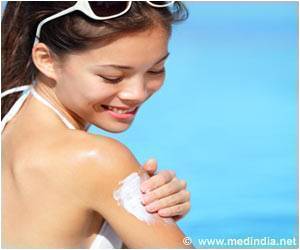Melanin like nanoparticles have been developed which offer good UV protection and show promise as a good ‘natural’ sunscreen.
Highlights:
- Melanin cells provide skin, hair and eyes their characteristic color and have UV protectant effect.
- A research team from WC San Diego has developed nanoparticles that mimic melanin cells and protect skin cells from harmful UV rays.
- The use of these synthetic melanin nanoparticles in sunscreen is to offer protection which is closest to that provided by the naturally occuring melanin.
Dr. Gianneschi stated that the high prevalence of diseases associated with improper melanin production, along with an interest in developing polymeric materials that were similar to melanin, encouraged the research team to develop melanin like materials.
What is Melanin?
Melanin is responsible for the color of our skin, hair and eyes. This is produced by the body by different cells in different animals, for example in the skin of reptiles and in the feathers of birds.We are constantly exposed to UV rays in our daily lives,, which affects the function and survival of cells in the body. Skin pigmentation is important for photoprotection, as melanin, besides being a UV absorbent, is also known to have an antioxidant with radical scavenging functions. Earlier studies have shown that people with darker skin have a lower incidence of skin cancer when compared with individuals who have lighter skin.
Though the benefits of melanin are well known, it is difficult to isolate melanin and it is easier to synthesize it. The research team led by Gianneschi, developed nanoparticles that were synthetic melanin, and which were found to mimic the natural melanin that were found in the feathers of birds.
The scientists believed, that the novel melanin like nanoparticles would be taken up by keratinocytes, as they resembled the melanosomes that were found naturally. The keratinocytes are the most commonly found cells that are present in the outer layer of the skin, the epidermis.
- uptake
- transport
- spread
- UV protection
- the synthetic nanoparticles that were developed by the scientists were taken up by the keratinocytes
- they were distributed like normal melanocytes
- these nanoparticles protected the skin cells from DNA damage
Differences in Skin Pigmentation
- the difference in the melanogenic activity
- the type of melanin produced in melanosomes
- the number and size of melanosomes
- the melanin content range from 17.9% to 72.3%
Adapting the mechanism of UV protection afforded by the naturally occurring melanin into synthetically developed melanin, like nanoparticles, will ensure better protection against the harsh rays of the sun.
References:
- The Protective Role of Melanin Against UV Damage in Human Skin - (https://www.ncbi.nlm.nih.gov/pmc/articles/PMC2671032/)
- What gives skin its color? - (https://www.aad.org/public/kids/skin/what-gives-skin-its-color)












